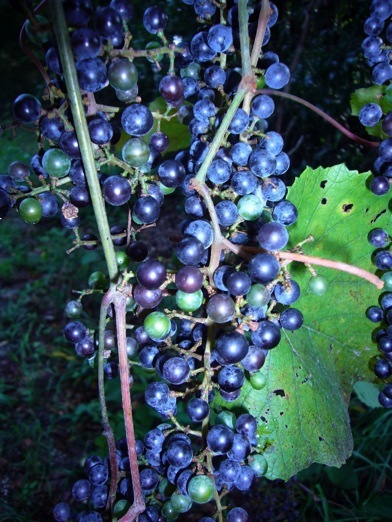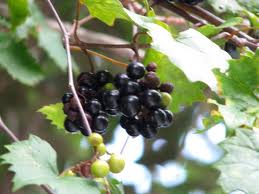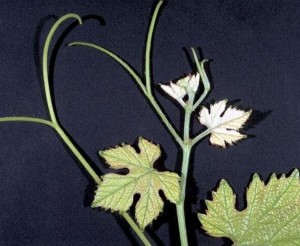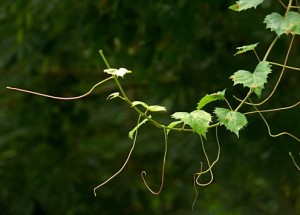Who ever first wrote the phrase “grapes of wrath” certainly must have been trying to identify a particular grape vine.
Grapes are at the same time easy to identify and maddening to identify. That one has a grape is pretty easy to sort out. Deciding which grape you have can bring on insanity. That problem is compounded in The South because there are native grapes, perhaps escaped hybrid grapes, and a lot of cross breeding by man and Mom Nature…. And the cause of it all is Pierce’s Disease.
Biologist Newton B. Pierce was studying grape disease in California about a century ago. At the time a mysterious disease affecting grapes was called Anaheim Disease. It was later was found to be the same disease causing problems in Florida. The disease was controlled in California but not in The South. While Pierce made great strides with the disease –it was renamed after him — it was not until 1978 that the insect-carried bacteria involved was finally identified. It was a detective story 400 years in the making.
In the 1500’s, a century before the Pilgrims landed at Plymouth Rock and three hundred years before California became a state, the Spanish in Florida noticed a lot of wild grapes growing. They made wine from the native grapes and planted grapes from back home in Spain. Unfortunately, the European grapes died, and for more than 300 years that was the story of growing non-native grapes in Florida.
In 1891 some 60 grape varieties were planted mid-state and they, too, died. In 1894 over a thousand acres were planted further north in the state. They perished as well. It looked like the end of growing non-native grapes in Florida. Then the state’s agricultural service got involved and began hybridizing varieties of grapes that could be grown in Florida. They had early successes and over the course of several decades some of those successful hybrids escaped as well. So Florida has five kinds of grapes: Native muscadines, grapes believed descended from muscadines and early plantings of European grapes (let’s call them escaped cultivars) intentional hybrids under cultivation, intentional hybrids that have naturalized (often found unattended near old homesteads) and nearly any combination of the above. Now you know why grapes can be maddening. (If that is not complicated enough some now think the forked-tendril grapes are not escaped cultivars but native. More DNA testing might sort that out.)
The local muscadines and “escaped cultivars” (if that is what they are) fall into two groups, which as a forager you will come across from Florida to Texas. First is the pure muscadine native which has a single tendril with six to 30 grapes per cluster, not bunch, see at left. The second is group has split tendrils and bunches of grapes of 30 or more, see photo at top. Now exactly which grape it is can be confusing. Not counting those specifically under cultivation you can find in the local wild Vitis rotunifolia, Vitis munsoniana, Vitis shuttleworthii, Vitis aestivalis, Vitis cinerea, and Vitis vulpina. There are also many subspecies as well and over the years local tribes also spread the crossbreeds.
If it has smooth bark, an unforked tendril, smooth, non-hairy leaves and you are north and west of the Suwanee River and the cluster of grapes number six to eight, it is probably V. rotundifolia. If you on the peninsula of Florida and it has smooth bark, non-hairy leaves, the tendril is unforked and the grapes are a cluster of 12 to 30 berries, then it is probably V. munsoniana. though that species might actually be a variety of V. rotundifolia. If you are in north or west Florida and you think you have V. rotundifolia or V. munsioniana but the bark on mature stems shreds in strips or squares you have V. vulpina.
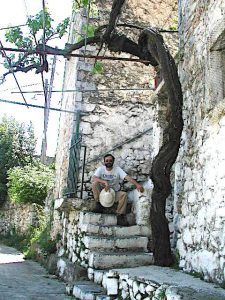
Green Deane with grapevine at his grandfather’s house in Karea, Greece, spring 2000.
Now it gets sticky: If you have a forked tendril, a thick grape leaf that’s hairy below (whitish short hairs, sometimes light brown, that resemble felt) wrinkled on top (think quilted mattress) a downward curve from the mid-rib and a large semi-sweet fruit, you are in the lower two-thirds of the state and your feet could be wet, you could have V. shuttleworthii, which perhaps a variation of V. aestavalis. If you live in Texas and think you have a V. shutteworthii but the grape tastes fiery pungent, you have V. candicans. Incidentally, V. shutteworthii is the direct ancestor of the cultivated “Stover” grape.
If you have a forked tendril, a thin flat leaf, smooth on top, but hairy below (rust-colored hairs that are NOT felt-like) and you are in New Jersey or below, you probably have V. aestivalis, which has at least four subspecies, V. sola, V. simpsonii, V. smallinana, and V. divegent. The V. aestivalis and V. simpsonii was used in the creation of the Lake Emerald and Norris varieties. The V. aestivalis is also in the ancestry of V. bourquiniana varieties of Herbemont and Lenoir.
If you have a forked tendril, the leaf is wrinkled dull green on top, white hairy below, branchlets look white or gray and the leaf base is deeply indented, and you are in the northwest portion of the state it could be V. cinerea. That is the most common grape in southeastern North America, excluding Florida.
To recap, if possible: If it is a grape with smooth bark, a round leaf, and probably toothy, with a single tendril, it is a muscadine, V. rotundiafolia to the north and west of the state, V. munsoniana to the middle and south. If you have all that and the mature bark is in strips or squares, it is V. vulpina.
If it has a forked tendril, the leaf is wrinkled on top and hairy underneath, and you are in the lower two thirds of the state and your feet are wet, it is probably V. shuttleworthii. If the leaf is smooth on top, hairy below, and has a forked tendril, and your feet are dry it is probably V. aestivalis. If it is wrinkled on top, hairy below, has a gray cast and you live in the western part of the state and north, it is V. cinerea. Whew!
If that is not confusing enough some argue the muscadines should not be in the Vitis genus at all and are rightfully the subgenus of Muscadinia because they have two less genes than other Vitis members. They would also make at least two more species in the subgenus. I should also mention that bringing into The South grape roots or plants from elsewhere will probably end in death. Pierce’s Disease is known to kill off at least 300 different species of grape.
One question I hear often is why aren’t the native grapes producing? They always seem not to have grapes. There are two answers: One is 90% of the vines have male flowers and all they do is basically lie around drinking sun all the time and belching oygen. And the gals? They fruit sporadically. However, the so-called non-native escaped cultivars produce almost every year.
As for pronunciation they are VEE-tiss (grape) row-tun-dee-FOH-lee-ah (roundleaf) es-tuh-VAL-uhs (of the field) sin-EER-ee-uh (the color of cinders, ashes) KAND-ik-anz, kan-DEEK-anz (white or wooly) vul-PEE-nah (fox) munso-nee-ANN-ah, simp-SON-ee-eye, bore-quin-nee-ANN-ah, ShuttleWORTH-ee-eye
Three tidbits:
- If you make grape jelly from muscadines don’t crush them bare handed or bare footed. The high acid content can lightly burn your hands or feet. Also, grape sap is drinkable.
- The grape vine, however, has a peculiar vascular arrangement. If you cut the vine it will not leak water unless you invert it. You can get a quart or more from a one-foot piece.
- In all English dialects except American English “vine” means the grape vine. In American English “vine” can mean many plants, not just the grape vine.
Green Deane’s “Itemized” Plant Profile
IDENTIFICATION: Grapes are woody vines with tendrils. Vines without tendrils that look like grapes are not grapes. The leaves vary greatly in shape from serrated and round to heart-shaped and smooth to lobed and hairy. The seeds of the grape are always tear-drop shaped. A grape-look alike is the moonseed which has seeds that are shaped like a crescent moon. Grapes in Florida tend to grow in clusters of two to 10, or bunches of 20 to 30 or more (not counting loss of numbers to birds and foraging humans.) Fruits are blue to black. There are hybrids under cultivation — some 300 different ones — that can be green, red, blue or black and are often very large.
TIME OF YEAR: Mid-summer to late fall in Florida, more towards fall as one goes farther north. Locally September first is a good date to aim for.
ENVIRONMENT: Grapes like full sun, good drainage and a healthy amount of water. But, they will survive in dry areas, putting on small fruit. They can even be found growing in Florida swamps, so they are very adaptable.
METHOD OF PREPARATION: Out of hand as they come off the vine. They can be made into jelly, jam, wine, raisins, fruit leather; the seeds can be pressed for oil and the young leaves boiled and eaten. The leaves of the hybrids are preferred to the muscadines. Muscadines can be high in acid so when crushing to make jelly don’t use your hand. Oh, and the seeds can be used to make grappa.

